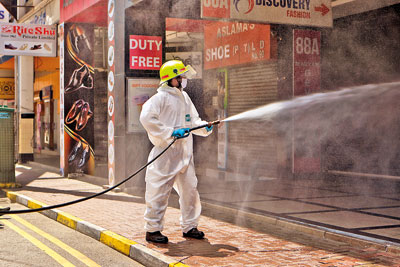Sunday Times 2
Coronavirus: Safety concerns over disinfection sprays
According to global scientific consensus, sanitising hard surfaces that are frequently touched, frequent handwashing to prevent cross-contamination and self-contamination, social distancing of two-metres, wearing protective facemasks and good general hygiene practices are more conducive methods in protecting people from SARS-Cov-2.

For spraying to be hazard-free, proper safety controls should be in place. Pic by Sameera Weerasekera
However, the effectiveness of disinfecting solutions is a concern. According to the US Environmental Protection Agency (EPA) and other scientific data, only a few chemicals are recognised to be effective against the coronavirus. The effectiveness further depends on the concentration, the surface contact duration and the porosity of the surface.
Efficacy may be challenging to prove due to the constraints of testing for pre- and post-viral loads of the exposed surfaces. Surgical or cloth masks do not provide sufficient protection from inhalation exposure to chemicals.
Is spraying chemical on surfaces harmful?
Most of the chemicals used to spray as surface disinfectants may not be recommended by manufacturers to be sprayed haphazardly with no proper safety controls in place. Some of these chemicals that can be applied topically as solutions relatively safely may cause different reactions when sprayed or aerosolised and enter the body through the respiratory tract. During spraying, the chemical particles break into sizes of aerosols or atoms which can significantly increase the inhalation of the chemicals.
Increased duration of exposure and frequency further augment the harmful effects. The toxic dose for children may be significantly greater than that for adults. There is little or no research done on exposure to these chemicals among children. In adults, exposure to chemicals has caused local as well as systemic damage to the body such as respiratory difficulties and damage to the central nervous system. Damaging the respiratory system by inhalation of these chemicals may further aggravate the harmful effects of SARS-CoV-2 on the respiratory system.
Acute allergic reactions or acute toxicity to the exposed chemicals may be rare but very much a possible medical emergency. If surfaces in a building are disinfected, the residues of the chemical released as vapours shall remain in the atmosphere until they are removed through natural and/or mechanical ventilation.
Therefore, a good practice is to open all doors and windows after surface cleaning to naturally ventilate the areas, thereby removing any residual chemicals that may cause adverse ill health to humans especially through inhalation. If immediate or early occupancy of the area is required, the only method of preventing such exposures is to wear protective equipment such as a half face respirator with appropriate filters
and goggles.
Selecting disinfectants
EPA and the list from the European Commission have recommended chemicals that destroy the SARS-CoV-2 virus in their effective concentrations and contact durations. Avoid using chemicals from manufacturers with generalised terminology and does not include the proper composition in their Safety Ddata Sheet (SDS).
All chemical manufacturers or distributors irrespective of use as surface disinfectant or hand sanitisers must provide the safety data sheet to the users containing information on the chemical composition, safe handling and storage, health and safety concerns, exposure controls and first aid measures.
Is it safe?
Any user of a chemical must familiarise themselves with the Safety Data Sheet (SDS) of the chemical in question prior to use. This will provide information on the hazards associated with the chemical, the composition/ingredients, first aid measures, firefighting methods, addressing accidental releases, how to handle the chemical safely and safe storage, exposure control and PPE, physical and chemical properties such as flashpoints and explosive limits, toxicological information and many other relevant concerns, to name a few out of the 16 topics covered in a SDS developed as per the framework provided by the Globally Harmonized System (GHS).
This familiarity will allow the user to make an informed decision on the chemical safety and ensure relevant control measures are in place to minimise the hazards. If in doubt, it is strongly advised to get the assistance of a professional. Manufacturers and clients are accountable for any health and safety impact associated with the exposure of persons who are exposed to chemicals. Therefore, every possible action to understand and minimise the potential hazards and risks especially to children must be taken.
(Note: The authors have published an article in the Occupational Medicine Journal, a publication of Oxford Academic, United Kingdom. Link:https://academic.oup.com/occmed/advance-article/doi/10.1093/occmed/kqaa078/5830872?searchresult=1)
(About the Authors: Dr. Aseni Wickramatillake is a specialist in occupational health and safety, and an expert in industrial hygiene. Artha Salgado is the Secretary of the Workplace Safety and Health Association (https://wsha.co) and practices health and safety in a regional capacity at a large multinational organisation. Dr. Changa Kurukularatne is a specialist in infectious diseases, infection prevention and control, and an expert in outbreak response and disaster management.)
Correspondence:
COSHlanka@gmail.com

